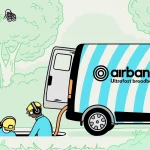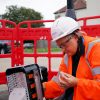London Full Fibre ISP G.Network Denies Warning it May Collapse

London-focused UK gigabit-broadband ISP G.Network, which is currently investing around £1bn to deploy a new Fibre-to-the-Premises (FTTP) network across the city, has said a recent newspaper report (Sunday Times) that alleged the company had recently warned of the risk it “could go under” are “simply not true“
The provider, which reports to have already covered 400,000 premises across London (up from 300k in Jan 2022) with their FTTP network, holds a long-term aim of reaching 1.3 million premises by around the end of 2026. Most of their build is currently taking place across the Boroughs of Westminster, Camden, Kensington and Chelsea, Hammersmith and Fulham, Islington, Hackney and other Inner London boroughs.
However, over the weekend the Sunday Times (paywall) alleged that the operator had recently “warned of the risk that it could go under” and was “is in talks with its banks about raising further capital,” which the paper then used as an example to highlight why Ofcom and the Government are currently reported to be developing a rescue plan for alternative networks (AltNets) that might fold.
Advertisement
The idea of creating contingency plans for AltNets (and their customers) that get into trouble is nothing new (here) and is believed to reflect two approaches – a revised Supplier of Last Resort (SLR) style process to help migrate customers away to another network and the possibility of a rescue scheme (“special administration“) – similar to those deployed in the energy sector.
The rescue scheme may involve using some public funding to help cover the costs of a large failure (i.e. costs that are too big to pass on to a potential buyer of a troubled network), but none of this has been finalised yet and some of it could be controversial.
Nevertheless, it was a surprise to see the comment about G.Network, given how they’re still in the early phase of build and have already managed to attract a significant level of investment. The ISP has been quick to deny the newspaper’s report.
A G.Network Spokesperson told ISPreview.co.uk:
“The claims in the Sunday Times that G.Network warned that it “could go under” are simply not true. G.Network filed its statutory accounts this month on a ‘going concern’ basis.
G.Network continues to grow steadily amid healthy demand and is backed by strong and extremely supportive long-term shareholders.”
The company’s latest annual accounts to 31st March 2022, which are indeed filed on a ‘going concern’ basis, noted that their turnover for the year was £4.328m (up from £3.182m) and their operating loss had hit £37.4m (up from £22.8m) – not unusual given the focus on spending big to build a new network. The payback period for such builds can be very long, up to c. 10-15 years, thus investors tend to understand that building a new network and generating take-up takes time.
Advertisement
The company’s accounts also reported that it had ended 2021 with a total of 340,000 premises passed and 8,664 connected customers, which is up from 180,000 premises and 3,477 customers in the year before (roughly double). The company’s average group headcount is now 645 (up from 263). Just as comparative example, Netomnia’s young FTTP network attracted around 10,000 customers for 130,000 premises passed in June 2022 (here), while older altnets like Hyperoptic tend to have much higher take-up.
As we’ve said many times before, the UK has become home to a mass of new altnet providers (100+), many of which are backed by many millions – and in some cases even billions – of pounds in private investment. Quite a few of these also hold major plans to expand gigabit-capable Fibre-to-the-Premises (FTTP) based broadband ISP networks across the country (Summary of UK Full Fibre Builds).
Speaking more generally, the market is unlikely to be able to support all of those players going forward, particularly in areas where there’s a lot of overbuild between several operators. Dense urban areas might be able to support up to 4-5 gigabit players, but this model becomes increasingly strained the further out you go due to high build costs and sparse populations (i.e into smaller towns and rural areas, where state aid support is often needed but competition is less).
Suffice to say, a growing wave of consolidation is widely expected, since not all of those altnets will be able to generate the take-up they need to convince investors to keep the money taps flowing. The challenge then becomes valuing such networks, particularly in areas where there may already be lots of competitive infrastructure (i.e. this could diminish the value of the fibre in the ground, which is normally a key asset with high value).
Advertisement
The fact that the Government and Ofcom are looking at how they can best support the different outcomes from all this is a prudent one. But it should be remembered that most networks are still in the early ramping-up phase of build, and we continue to see plenty of new funding announcements, which indicates a high tolerance for the risks, at least for now.
The consolidation that we have seen thus far has been at the smaller end of the scale and of the largely un-disruptive and more tactical variety. For example, CityFibre acquired FibreNation from TalkTalk (here), Swish Fibre gobbled up People’s Fibre (here), 4th Utility consumed Vision Fibre Media (here) and CommunityFibre acquired Box Broadband (here).
More consolidation will no doubt follow in the next few years as investors gradually put more of a microscope on progress (take-up and build rate), but over time some networks will definitely start to find it harder to secure a buyer than others. However, right now, having fibre in the ground still holds a lot of value.
Mark is a professional technology writer, IT consultant and computer engineer from Dorset (England), he also founded ISPreview in 1999 and enjoys analysing the latest telecoms and broadband developments. Find me on X (Twitter), Mastodon, Facebook, BlueSky, Threads.net and Linkedin.
« Researcher Demos Starlink’s Potential for Satellite Navigation























































8664 out of 340 000 is pretty bad take up, hopefully it improves as people’s contracts expire.
Anecdotally they take several months to have an area ready to order after digging it up, leaving time for other providers to swoop in. I’ve never had an email enquiry replied to either.
It looks like they have grown too quickly and certain bits can’t keep up.
Taking many months to get an area ready post-build is not uncommon in this market.
No different to many other altnets. They often rock up thinking they’ll get ridiculously high take up, and then they don’t. And then other operators rock up, and then the traditional players rock up…
The business models are flawed. The end result and goal is an ntl:telewest > virgin media merge, merge and merge again.
The numbers don’t add up. The penetration number is only 2.5% which is extremely bad, which could mean they’ve fudged their 340k passed number in 2021
If their 2021 number is correct, then it means that their 400k number is mediocre because it would mean only a figure of 10k passed per month and significantly much worse than their previous year, which saw growth from 180k to 340k. Looking at TBB, they don’t even seem to reach 300k today
Also one thing that the article does not mention is 1- the rise in interest rates, money is no longer as cheap as it was before and it will hurt those especially with variable rates and 2 – the business tax increases that will come into fruition by the Biden government that will raise the sea level, placing companies just barely on the surface of the water, under water
I want to know who told the FT in June that they had 55,000 subscribers
John: your constant use of americanisms, I noted a few occasions where ‘z’ was used instead of British English ‘s’, and repeated references to Biden really make me wonder.
In the UK businesses pay corporation tax, the one that’s going up, on profits. These guys aren’t making any. Not even close.
Businesses treading water, reliant on an accommodating tax policy, are likely not the best use of capital and their going under is surely a positive under the libertarian, capitalist, free market model?
This is a Biden global tax. They have cranked up taxes at home, as well as other anti business policies, and have compelled other countries around the world to follow suit so that companies don’t start escaping left and right to countries with better tax policies. The end goal of eliminating competitiveness in attracting companies is no secret
Any tax on profit hurts both the companies making profit and the consumer who may have to end up footing the tax as usually what happens with any tax. If the govt raises a tax on sugar, it is not Tesco who will take the hit, Tesco will rase the price of products affected by the sugar tax. Even if Gnet is not making a profit, Hyperoptic may be and this tax will hinder their rollout
An anti business tax is not in the interest of free market capitalism
Yes, please let’s try to avoid bringing the USA and American politics into this, it’s too far off-topic. The UK is plenty crazy enough without that.
We need to see the breakdown of residential vs commercial connections to really judge. We use them as a commercial provider, and they were something like half the cost of the established players (BT, Colt etc.). Even though they are cheaper, they still make about 5 times the revenue from a commercial connection compared to their residential pricing. So low numbers may be made up for by better revenue per subscriber numbers.
You’re right but even if commercial makes 3x or 5x more revenue, the penetration is still very low. If you multiply the entire pen by 3 it’s still below 10%
I’m honestly kind of shocked about the 2.5% number, it seems too high. I live in a flat in Central ish London, and they dug our whole area up in covid and my order was stuck for a year before they cancelled it due to no wayleave. I’ve spoken with our freeholders who claim to have never heard from them. Meanwhile they have granted wayleaves to community fibre, hyperoptic and vorboss the first two are live and installed in my flat. Good luck to them but..
they will go under and soon, started letting people go
Got a few friends that used to work for G.Network and they have been made redundant in the last 3 months . No doubt they will
be going under soon
We need to see evidence of that? As hearsay is not proof or useful on anonymous comments.
Mostly my opinion:
The costs of digging in the inner parts of London are brutal. The density provides some efficiency but swiftly offsets it with the costs of traffic management, etc.
The uptake when competing with Hyperoptic in MDUs and Community Fibre outside of them won’t be great.
Their uptake according to their own numbers is awful. Forget contracts, etc, they are well below the levels some others are seeing due to their fixating on building, at high cost, in competitive areas.
I’m sure they’re a going concern for now, however:
“How did you go bankrupt?”
Two ways. Gradually, then suddenly.”
― Ernest Hemingway, The Sun Also Rises
Like an idiot once they dug up my street I emailed them to earmark me for when my community fibre contract is up ( that was before their £2 announcement ). They’ve been spamming me ever since ( no unsubscribe link in emails ) so I blocked the sender reporting it as spam; they seem desperate.
I was very suprised to see less than 9K installs by end of March 2022 as given the large numbers of roads they have been digging up in Central London I expect a much larger take up. On the other hand I ordered an install in July 2020 and am still waiting for the actuall installation to take place after waiting for multiple surveys, wayleave agreements etc. so perhaps they are suffering from the complexity of dealing with leashold buildings which will be common in their targgeted install area.
Considering 8664 connected out of 340000 passed I would say they either build their network in the wrong places or people living there have no idea about their existence/availability. Also some of the altnets makes impression that they are in the process of money laundering rather than doing anything or they are very poorly managed.
Walking around London and seeing where they build I’m not that surprised about the lack of take up. The difference between the homes passed and ‘ready for service’ homes must be significant given number of MDUs and distance the network is left from the actual buildings. So many tobies dropped in locations that will be practically impossible to actually install from.
A lot of the toby boxes that you think are miles away from the building are actually sat just the other side of the basement wall, you can often see a difference in the pavement finish to mark out the public highway vs. the boundary of the building.
We are now seeing places with 3 or 4 FTTP suppliers. Difficult for some to exist?
The government really shouldn’t replicate the support provided to energy sector companies, an on-going massive haemorrhage of cash. The maximum that should be provided is (say) a month of support to give time for customers to transfer to another ISP.
No more Bulbs!